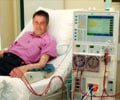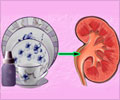A study appearing in an upcoming issue of the Clinical Journal of the American Society of Nephrology (CJASN) says that among women on long-term hemodialysis, many are sexually inactive. Additionally, sexual dysfunction is considerably less common than previously reported.
The findings suggest that efforts to assess and treat sexual dysfunction among women on dialysis likely require one-on-one discussions between physicians and patients to identify those women who truly suffer from this problem and who wish to consider treatment options.Previous research has reported that sexual dysfunction is very common among women with end stage renal disease (ESRD) who are receiving chronic hemodialysis, but the studies did not effectively distinguish sexual dysfunction/difficulty from sexual inactivity.
To differentiate between these and estimate the prevalence of true sexual dysfunction in this population, Steven Weisbord, MD, MSc (VA Pittsburgh Healthcare System and University of Pittsburgh School of Medicine) led a team that prospectively assessed sexual function in a group of 125 women on hemodialysis. Between 2009 and 2011, the women completed questionnaires monthly for six months and quarterly thereafter.
Among the major findings:
- Answers on 89% of quarterly assessments suggested the presence of sexual dysfunction, due largely to patients describing sexual inactivity, which was reported on 82% of assessments.
- The most frequently described reasons for sexual inactivity were lack of interest in sex (43%) and lack of a partner (39%), but rarely sexual difficulty (2%). Moreover, on 76% of assessments in which lack of interest was cited as a reason for sexual inactivity, women described being moderately to very satisfied with their sex life.
- Overall, women were moderately to very satisfied with their sex life on 64% of assessments
- Women expressed interest in learning about the causes of and treatment for sexual dysfunction on just 5% of all assessments.
While many women receiving chronic dialysis had scores that suggested sexual dysfunction, this was due to a high prevalence of sexual inactivity, which itself was not associated with sexual dissatisfaction among most women. Therefore, most women on dialysis do not appear to have sexual dysfunction or difficulty. Most-including those with a lack of interest in sex-are satisfied with their sex lives, and few wish to learn about treatment options.
"Sexual inactivity is particularly common yet does not appear to be bothersome to many women on dialysis," said Dr. Weisbord. "Carefully considering patients'' perspectives and preferences is essential to evaluating the presence and importance of a condition like sexual dysfunction," he added.
In an accompanying editorial, Fredric Finkelstein, MD and Susan Finkelstein (Yale University) noted that one of the strengths of this study is that "it underscores the point that the sexual inactivity of end stage renal disease patients needs to be seen in the context of the patient''s overall medical problems, burden of the treatment regimen, and life situation; sexual problems, as with other areas of difficulty for the ESRD patient, cannot be seen in isolation." They added that "the… paper emphasizes for us that it is critically important not just to document with a validated tool an area of patient ‘dysfunction'' but that we need to understand the importance of this for the patient."
Study co-authors include Maria Mor, PhD, Mary Ann Sevick, ScD, RN, Anne Marie Shields, MSN, Jamie Green, MD, Paul Palevsky, MD, Robert Arnold, MD, Michael Fine, MD, MSc, and Steven Weisbord, MD, MSc.
Disclosures: The authors reported no financial disclosures. This study was supported by the Department of Veterans Affairs Health Services Research and Development Service.
The article, entitled "Sexual Function, Activity, and Satisfaction among Women Receiving Maintenance Hemodialysis," will appear online at http://cjasn.asnjournals.org/ on December 19, 2013.
The editorial, entitled "Sexual Inactivity Amongst Hemodialysis Patients: The Patients'' Perspective," will appear online at http://cjasn.asnjournals.org/ on December 19, 2013.
The content of this article does not reflect the views or opinions of The American Society of Nephrology (ASN) or the Department of Veterans Affairs. Responsibility for the information and views expressed therein lies entirely with the author(s). ASN does not offer medical advice. All content in ASN publications is for informational purposes only, and is not intended to cover all possible uses, directions, precautions, drug interactions, or adverse effects. This content should not be used during a medical emergency or for the diagnosis or treatment of any medical condition. Please consult your doctor or other qualified health care provider if you have any questions about a medical condition, or before taking any drug, changing your diet or commencing or discontinuing any course of treatment. Do not ignore or delay obtaining professional medical advice because of information accessed through ASN. Call 911 or your doctor for all medical emergencies.
Founded in 1966, and with more than 14,000 members, the American Society of Nephrology (ASN) leads the fight against kidney disease by educating health professionals, sharing new knowledge, advancing research, and advocating the highest quality care for patients.
Source-Newswise














